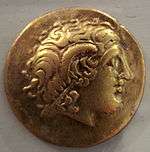Arverni


The Arverni were a Celtic tribe.[1] The tribe was located in what is today the French Auvergne region, which derives its name from the Arverni. One of the most powerful tribes in ancient Gaul, the Arverni opposed the Romans on several occasions. Their most important stronghold was Gergovia, near the present-day commune of Clermont-Ferrand.
Early history
The Arverni are known to have had the most powerful tribal hegemony in Gaul during the 3rd and 2nd centuries BC under their kings, Luernios, and his son Bituitus. Their power was based on strong metallurgic technologies and weapons, elaborated and rich agriculture and catering, mining, trade and military dominance over their neighbours with tributes paid to them. But when Arvern king Bituitus was defeated by the Romans of Quintus and Gnaeus Ahenobarbus in 121 BC, their ascendancy passed to the Aedui and Sequani. Unlike the Allobroges, who were brought under direct Roman rule as a result of the Celtic wars of the 120s, the Arverni negotiated a treaty that preserved their independence, though their territory was diminished. No further Arvernian kings are mentioned in the historical record between 121 BC and 52 BC, and they may have adopted a constitutional oligarchy at this time. However, there were at least two later attempts to re-establish rulership by Celtillos and Vercingetorix. The defeat of the Arverni led directly to the establishment of Gallia Narbonensis as a Roman province, referred to simply as the Provincia so often that a part of the ancient region is today known as Provence.
The King Luernios was mentioned in writing by the Greek ethnographer Posidonius. Luernios was known to have scattered gold and silver coins to his followers while riding in his chariot. Under Luernios, the Arverni were at the head of a formidable Gallic military hegemony which stretched from the Rhine to the Atlantic coast.
They joined Bellovesus' migrations towards Italy, together with the Aeduii, Ambarri, Aulerci, Carnutes and Senones.[2]
Gallic Wars

The Arverni later played an important role in the Gallic Wars of Julius Caesar from 58 BC to 51 BC. At first the Arvenian nobles tried to avoid confronting Caesar during his early incursions. They executed the leader Celtillus, evidently for trying to gain sovereignty over all the Gauls.[3] In 52 BC, Celtillus' son Vercingetorix rallied his supporters to fight the Romans, but was expelled from Gergovia by the nobles, including his uncle Gobanitio. He then raised a great army in the country, and returned to the city where he ejected his opponents and was declared king.[3] This accomplished, Vercingetorix forged an alliance with at least 15 Gallic tribes, requesting the presence of sons of chiefs to prove their alliance. He then led the majority of the Gauls and won the Gergovia battle against Julius Caesar and his cavalry did marvels in pursuing the Roman troops. After Julius Caesar saved half of his legions and received food from other Gauls, he went further north to fight weaker opposition. Vercingetorix was defeated by Caesar at the Battle of Alesia, after several months where the legions built 14 ranges of military equipment to block the Gallic soldiers. After several weeks of support from the western Gallic people with huge troops coming to support Vercingetorix, the Gauls were very close to merge on 2 occasions before the sunset. When the western Gallic people decided to depart, Vercingetorix took the decision to surrender to save the people of Alesia.[4]
The Arverni territories and over 75% of the Gauls (the allies and tributers to the Arverni and Vercingetorix) were subsequently incorporated into the Roman imperium.
See also
- Quintus Fabius Maximus Allobrogicus: conquered King Bituitus
- Alba Fucens: town where Bituitus was held after capture
References
- ↑ "Arverni" in The New Encyclopaedia Britannica. Chicago: Encyclopaedia Britannica Inc., 15th edn., 1992, Vol. 1, p. 611.
- ↑ Livius, Ab Urbe condita 5.34-35.3.
- 1 2 Julius Caesar, Commentarii de Bello Gallico, book 7, ch. 4.
- ↑ Julius Caesar, Commentarii de Bello Gallico, book 7, ch. 89.
